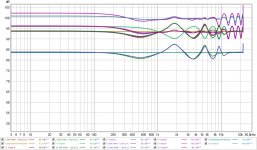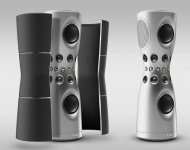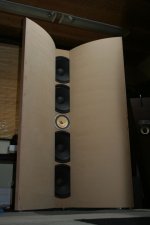I found the same with the version I tried before linear phase was clearly better good to know it still holds true with the new settingsThe difference between minimum phase mid/side EQ and linear phase for instance is more than subtle.
What measurement made it clear, as before you showed one with minimum phase that you thought looked better
I don't have the time right now to go into it, but basically it changes the inverse side balance of the opposite side of sounds to left (or right).
As said, the mid part contains both left and right material too. So a boost there, boosts the sides too. I'll try and show a few graphs later on, right now I have to get ready for work.
I was concentrating on the phantom part too much, we have to look at all signals that reach the ear. As soon as we use mid/side EQ, you introduce an inverse signal in the opposite channel. That's the reason it works at all, but use it too much and you loose the benefits.
What I'm trying to do is compensate for sounds that arrive from a stereo angle to look (or rather sound) like it's coming from the front. Same for the sides, a little compensation makes it sound like it's coming from the side, not the loudspeaker location. Counter-acting the cross talk where needed to achieve that.
More on it later 🙂... I have to run now. While the balance at the ears looks exactly alike, the difference is in the components that make the sum at each ear.
As said, the mid part contains both left and right material too. So a boost there, boosts the sides too. I'll try and show a few graphs later on, right now I have to get ready for work.
I was concentrating on the phantom part too much, we have to look at all signals that reach the ear. As soon as we use mid/side EQ, you introduce an inverse signal in the opposite channel. That's the reason it works at all, but use it too much and you loose the benefits.
What I'm trying to do is compensate for sounds that arrive from a stereo angle to look (or rather sound) like it's coming from the front. Same for the sides, a little compensation makes it sound like it's coming from the side, not the loudspeaker location. Counter-acting the cross talk where needed to achieve that.
More on it later 🙂... I have to run now. While the balance at the ears looks exactly alike, the difference is in the components that make the sum at each ear.
Last edited:
Did I answer the question in a reasonable way? I'd love to go further into it, but I'm also bubbling over with things to try (to advance these ideas).
So if you don't mind, I'll continue my investigation right now. Writing about it with graphs will take up a lot of time.
I'm running tests like these:
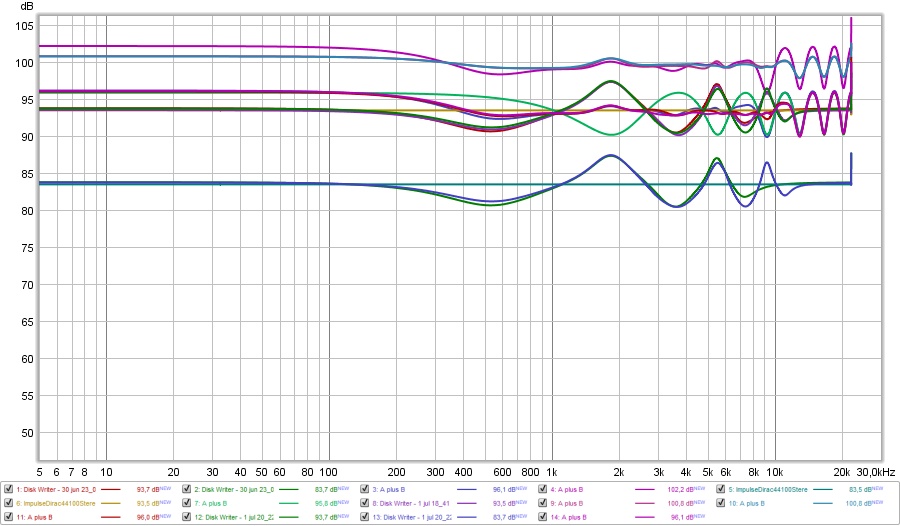
In the graph above, you see the mid/side EQ and it's effects on each ear.
Going with a 10 dB head shading, and the assumption that the delay between sound of the left side speaker arriving at the opposite right ear will take about 0.27 ms.
So I look at the left ear, the left ear with a bleed of the right channel and the right ear and the bleed of the left channel.
I do this for the phantom part (L+R) and L or R by itself. The EQ is meant to reconstruct what the sound at each ear would be as if the source was from straight forward, or the left by itself/right by itself.
With this type of EQ there are consequences, like I said before. I've gone into great length explaining that earlier in this thread, as it is a vital part of it's function.
Anyone willing can do these exercises themselves. Just figure out what the sound should be for sounds from straight forward, compared to the 2 sources coming from the front. The Fixing the Phantom Center thread has a lot of useful information on these principles.
The difference between min phase EQ and linear phase EQ lies in the content of the right channel for a left channel signal in the situation of using mid/side EQ. This can be seen in the Fr curve, the Spectogram/Wavelet view, but not in the sum of the signals at the ear. So the content of that opposed channel with only Left or only Right content playing differs.
So if you don't mind, I'll continue my investigation right now. Writing about it with graphs will take up a lot of time.
I'm running tests like these:
In the graph above, you see the mid/side EQ and it's effects on each ear.
Going with a 10 dB head shading, and the assumption that the delay between sound of the left side speaker arriving at the opposite right ear will take about 0.27 ms.
So I look at the left ear, the left ear with a bleed of the right channel and the right ear and the bleed of the left channel.
I do this for the phantom part (L+R) and L or R by itself. The EQ is meant to reconstruct what the sound at each ear would be as if the source was from straight forward, or the left by itself/right by itself.
With this type of EQ there are consequences, like I said before. I've gone into great length explaining that earlier in this thread, as it is a vital part of it's function.
Anyone willing can do these exercises themselves. Just figure out what the sound should be for sounds from straight forward, compared to the 2 sources coming from the front. The Fixing the Phantom Center thread has a lot of useful information on these principles.
The difference between min phase EQ and linear phase EQ lies in the content of the right channel for a left channel signal in the situation of using mid/side EQ. This can be seen in the Fr curve, the Spectogram/Wavelet view, but not in the sum of the signals at the ear. So the content of that opposed channel with only Left or only Right content playing differs.
Attachments
Sadly the S-curve article (the LoCo link in this post) is long gone... This has had a trmendeous influence on my use of mid/side EQ, as there were a couple of interesting documents linked on that site.
Wayback machine shows no previously saved results as it was on a userpage...
Ahh a search got me back on track: frankl's stereo pages - LoCofrankl's stereo pages - LoCo
Specificly this linked graph and shuffler schematics:
http://www.sengpielaudio.com/FrequenzabhHoerereignisrichtung.pdf
http://www.sengpielaudio.com/Shuffler.pdf
And linked in that one, a more detailed explanation of mid/side EQ:
http://www.audiosignal.co.uk/Resources/Stereo_shuffling_A4.pdf
A quote from that paper that is essential to understand:
Wayback machine shows no previously saved results as it was on a userpage...
Ahh a search got me back on track: frankl's stereo pages - LoCofrankl's stereo pages - LoCo
Specificly this linked graph and shuffler schematics:
http://www.sengpielaudio.com/FrequenzabhHoerereignisrichtung.pdf
http://www.sengpielaudio.com/Shuffler.pdf
And linked in that one, a more detailed explanation of mid/side EQ:
http://www.audiosignal.co.uk/Resources/Stereo_shuffling_A4.pdf
A quote from that paper that is essential to understand:
Code:
Width settings and crosstalk
It is often useful to know what the gain of S (relative to
that of M) is, so that one knows how much width
increase has been applied. This can most easily be done
by measuring the crosstalk of a left only signal on to the
right channel (or vice-versa) – something that can be
done on the mixer's meters. The crosstalk is the same
whether the S/M gain is reduced or increased by a given
number of dB! If S gain is increased, this crosstalk is
out of phase but if the S-gain is reduced, the crosstalk
is in phase.
S/M gain Crosstalk S/M gain Crosstalk
dB dB dB dB
±0.0 –∞ ±7.0 –8.3
±1.0 –24.8 ±8.0 –7.3
±2.0 –18.8 ±10.0 –5.7
±3.0 –15.3 ±12.0 –4.5
±4.0 –12.9 ±15.0 –3.1
±5.0 –11.1 ±20.0 –1.7
±6.0 –9.6
The figures in this table are accurate only for the case
when S has no phase shift relative to M, and so are
most easily applied to frequency-independent width
control.
Last edited:
Yes 🙂Did I answer the question in a reasonable way?
Carry on 😉So if you don't mind, I'll continue my investigation right now. Writing about it with graphs will take up a lot of time.
This was the answer I was looking for, and makes sense, my brain is not working very well right now so I will have to leave a better understanding of the "inverse opposite" stuff till another point, sorry if I sent you off on a tangentThe difference between min phase EQ and linear phase EQ lies in the content of the right channel for a left channel signal in the situation of using mid/side EQ. This can be seen in the Fr curve, the Spectogram/Wavelet view, but not in the sum of the signals at the ear. So the content of that opposed channel with only Left or only Right content playing differs.
Yes 🙂
Carry on 😉
This was the answer I was looking for, and makes sense, my brain is not working very well right now so I will have to leave a better understanding of the "inverse opposite" stuff till another point, sorry if I sent you off on a tangent
“Inverse opposite” sounds like “upside down and backwards” to me.😀
Am I that incompetent to express myself? 😀
If you fire only the left channel, with mid/side EQ, the opposite channel will be the right channel. If you boost EQ at the sides, relative to the mid (L+R) it will create an inverse copy of the left signal into the right channel. If you cut the side signal, relative to the mid (L+R), it will create an in phase copy into the right channel.
See the table I've linked in my previous post. Now what can we do with that? What effect will it have?
If you fire only the left channel, with mid/side EQ, the opposite channel will be the right channel. If you boost EQ at the sides, relative to the mid (L+R) it will create an inverse copy of the left signal into the right channel. If you cut the side signal, relative to the mid (L+R), it will create an in phase copy into the right channel.
See the table I've linked in my previous post. Now what can we do with that? What effect will it have?
Am I that incompetent to express myself? 😀
Your competency is not in question, it’s more about our (my) level of understanding. 😛
I’ve been mulling over an idea for a line array that would involve using individual stacked full range driver modules rather than having all of the drivers in one tall vertically aligned cabinet. (Picture it as a spinal column of vertebrae.) That leads me to the question: is it entirely necessary to resort to software/electronics to properly dial in the sound of an array?
Setting aside for the moment the potential issue of varying center-to-center distances between drivers, my theory behind the individual modules is that they could be rotated horizontally within the same vertical plane to provide physical shading/steering instead of via software/DSP. I guess the only way to know for sure would be to build and test them. At worst, one could always move on to a software solution and/or would have lots of little desktop speakers to sell or give as gifts.🙄
Ronald, you’ve clearly taken this to another level and we all appreciate the effort you put in to advance the craft. I’d really appreciate your insight on this.
That's not a question with an easy answer... 
Have you seen the Bose array?
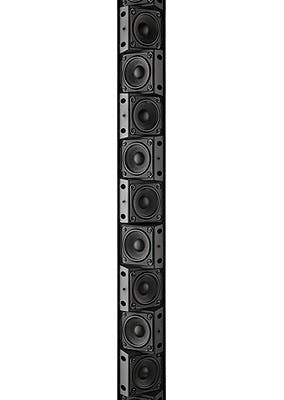
You want to create something like this, but on steroids? Meaning even more diversity between driver aiming? 😱
In all honesty I do believe something like what you propose would still benefit from software correction. Even if you solve the summing of the drivers, the top end on something like this is pretty hard to predict... I don't think there are many programs around that can sim something like that.
There have been enough passively controlled arrays. So that's not the issue... What do you think the benefits will be?
Personally I really like the direction we saw on the Lexicon speakers:
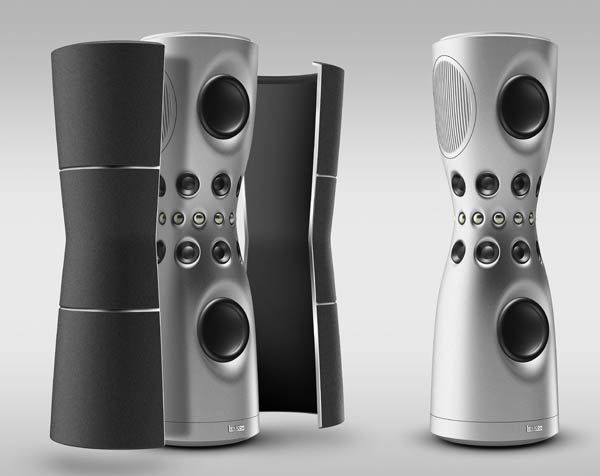
Something like that with a bit of software would be a ball to play with! 😀

Have you seen the Bose array?
You want to create something like this, but on steroids? Meaning even more diversity between driver aiming? 😱
In all honesty I do believe something like what you propose would still benefit from software correction. Even if you solve the summing of the drivers, the top end on something like this is pretty hard to predict... I don't think there are many programs around that can sim something like that.
There have been enough passively controlled arrays. So that's not the issue... What do you think the benefits will be?
Personally I really like the direction we saw on the Lexicon speakers:
Something like that with a bit of software would be a ball to play with! 😀
Attachments
The design I have in mind is similar to the Bose array in that it is composed of full range drivers all occupying the same size/shape enclosure. The enclosures are short cylinders. The top of each cylinder has a circle of indexed holes that the feet on the next cylinder’s bottom can nest into. The indexing allows for precise spacing for predictable driver offset angles and the nesting capability minimizes the distance between enclosures in order to present a relatively seamless gap between modules.
Steroids? I’ve often been accused of being ambitious when it comes to design and I suppose this is no exception. For a 7-8 ft (2.13-2.44 m) height it would mean somewhere between 16-24 drivers per side. (Current candidates include Vifa TC9, MA CHR-70, MA CHN-50, SB Acoustics SB65, but willing to investigate others.)
Benefits of a passive, physically-steered array? None, per se, except for simplicity and not having to deal with software. Again, if the solution lies in software/DSP I’d be willing to go that route; it just wouldn’t be my first choice. Much of this is mental exercise at the moment but I wanted to explore the possibilities as I do have a single module for the CHR-70 on the drawing board and it got me thinking, what if? Who knows if I will ever build it but, if not, perhaps it will give others food for thought.
Steroids? I’ve often been accused of being ambitious when it comes to design and I suppose this is no exception. For a 7-8 ft (2.13-2.44 m) height it would mean somewhere between 16-24 drivers per side. (Current candidates include Vifa TC9, MA CHR-70, MA CHN-50, SB Acoustics SB65, but willing to investigate others.)
Benefits of a passive, physically-steered array? None, per se, except for simplicity and not having to deal with software. Again, if the solution lies in software/DSP I’d be willing to go that route; it just wouldn’t be my first choice. Much of this is mental exercise at the moment but I wanted to explore the possibilities as I do have a single module for the CHR-70 on the drawing board and it got me thinking, what if? Who knows if I will ever build it but, if not, perhaps it will give others food for thought.
Whatever you end up doing, pack the drivers as close as you can for high frequency performance.
I may have had dreams of a 3 rows of full range driver array, outlined on a cilinder like surface and enough channels to play with 🙂.
On the other hand, a wave guide shaped array with unity/synergy like packed drivers would be fun too, a row of tweeters at the apex of the wave guide and the mid/low feeding trough the ports like a unity/synergy.
That way you could mimic an ultimate line of drivers actually acting as a seamless line over a very wide frequency range.
It would take a rather large budget to make though, lots of drivers needed.
The wave guide would look something like this:
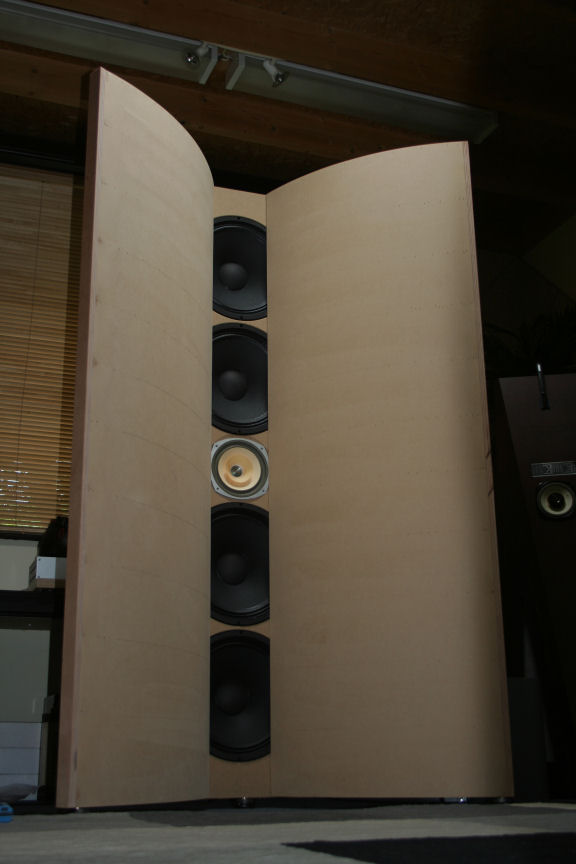
But picture the wings closer together, with a row of tweeters at the apex, with mids and lows feeding the wave guide trough bandpass holes following the rules of the unity/synergy in spacing. A bit more care at the mouth for diffraction (folded back with large radius).
Ah... dreams... 😀
I may have had dreams of a 3 rows of full range driver array, outlined on a cilinder like surface and enough channels to play with 🙂.
On the other hand, a wave guide shaped array with unity/synergy like packed drivers would be fun too, a row of tweeters at the apex of the wave guide and the mid/low feeding trough the ports like a unity/synergy.
That way you could mimic an ultimate line of drivers actually acting as a seamless line over a very wide frequency range.
It would take a rather large budget to make though, lots of drivers needed.
The wave guide would look something like this:
But picture the wings closer together, with a row of tweeters at the apex, with mids and lows feeding the wave guide trough bandpass holes following the rules of the unity/synergy in spacing. A bit more care at the mouth for diffraction (folded back with large radius).
Ah... dreams... 😀
Attachments
wow, this phantom center image thing you work on is very interesting
it reminds me about a swedish loudspeaker guy who does similar things to compensate for flaws with stereo sound, but he does it by using the loudspeaker baffle diffraction to his advantage, i believe he means that this correction can not be applied by an eq because the corrections should be applied to the loudspeaker on axis response only and none to the sides (off axis)
by looking on your frequency response graphs it sure looks like it can be done by choosing a driver and baffle layout to match
it reminds me about a swedish loudspeaker guy who does similar things to compensate for flaws with stereo sound, but he does it by using the loudspeaker baffle diffraction to his advantage, i believe he means that this correction can not be applied by an eq because the corrections should be applied to the loudspeaker on axis response only and none to the sides (off axis)
by looking on your frequency response graphs it sure looks like it can be done by choosing a driver and baffle layout to match
Well, my view on this is a bit different. Only in the exact sweet spot do we have the worst effects of cross talk, at both ears for phantom center sounds.
If we look at the balance at both ears, things will change quickly if one moves a little to either side of the sweet spot. But our ears being at a fixed distance helps.
What I'm trying to do here, is fix the phantom error at the ears, as if we hear a sound coming from straight forward.
The sides get a slightly different mix, as a sound coming from the side will still be different than our Stereo representative within a standard Stereo triangle setup.
This way I get to balance the sweet spot, however the effects of moving out of the sweet spot are not nearly as obvious compared to doing nothing at all. So in a way this still creates a larger sweet spot.
Anyway, it is working quite well for me, some others (mostly line array owners) have tried it and seem to agree. This most recent revisit of this mid/side EQ was an attempt at further refining my earlier results. However it turns out my earliest attempts were quite close to what I've found in these recent exercises. The biggest difference is that I've got a greater understanding of what seems to be happening at our ears. 🙂
That alone is worth the time to me. So far I've tried a couple of ways to fight cross talk. This mid/side EQ is still the best working solution I've come across.
I have thought about using diffraction as a tool, but that solution cannot influence the side panned sounds separately, and I've found that for me, this is one of the best parts of it all.
Mid/side EQ really is a strong way to get closer to that holographic sound stage. As long as the early reflections are properly attenuated. I can recommend it to anyone willing to try. This isn't specific to line arrays. It should work for every speaker setup that is able to avoid early reflections or if the room is properly treated to reduce the level of these early reflections.
Other ways to get similar results would be using a physical barrier.
Or to move way closer to the speakers to reduce the level of the cross talk compared to the direct sound. Earlier in this thread someone showed a 'Mohawk' type of barrier that seemed to help too 🙂.
If we look at the balance at both ears, things will change quickly if one moves a little to either side of the sweet spot. But our ears being at a fixed distance helps.
What I'm trying to do here, is fix the phantom error at the ears, as if we hear a sound coming from straight forward.
The sides get a slightly different mix, as a sound coming from the side will still be different than our Stereo representative within a standard Stereo triangle setup.
This way I get to balance the sweet spot, however the effects of moving out of the sweet spot are not nearly as obvious compared to doing nothing at all. So in a way this still creates a larger sweet spot.
Anyway, it is working quite well for me, some others (mostly line array owners) have tried it and seem to agree. This most recent revisit of this mid/side EQ was an attempt at further refining my earlier results. However it turns out my earliest attempts were quite close to what I've found in these recent exercises. The biggest difference is that I've got a greater understanding of what seems to be happening at our ears. 🙂
That alone is worth the time to me. So far I've tried a couple of ways to fight cross talk. This mid/side EQ is still the best working solution I've come across.
I have thought about using diffraction as a tool, but that solution cannot influence the side panned sounds separately, and I've found that for me, this is one of the best parts of it all.
Mid/side EQ really is a strong way to get closer to that holographic sound stage. As long as the early reflections are properly attenuated. I can recommend it to anyone willing to try. This isn't specific to line arrays. It should work for every speaker setup that is able to avoid early reflections or if the room is properly treated to reduce the level of these early reflections.
Other ways to get similar results would be using a physical barrier.
Or to move way closer to the speakers to reduce the level of the cross talk compared to the direct sound. Earlier in this thread someone showed a 'Mohawk' type of barrier that seemed to help too 🙂.
so, are you endorsing paraline?🙂
DIYers have had trouble getting smooth responses from them. I've wondered if FIR correction + 3D printing weren't the missing ingredients
DIYers have had trouble getting smooth responses from them. I've wondered if FIR correction + 3D printing weren't the missing ingredients
Endorsing paraline? Not yet! 🙂
As you said, not too many can brag about a successful implementation. I wouldn't want to try and print one on one of those home filament printers.
I'd go for at least something like an SLS printer (commercial printer services). I have thought of trying that, but have no application or need yet.
As you said, not too many can brag about a successful implementation. I wouldn't want to try and print one on one of those home filament printers.
I'd go for at least something like an SLS printer (commercial printer services). I have thought of trying that, but have no application or need yet.
My regular listening schedule is over for the summer months.. I don't have the house to myself that much. However every now and then I get a go. Not enough though to make large changes. So no big updates yet, what I have now does work very well. So just enjoying some listening time isn't a punishment.
No progress (due to lack of time) on the subwoofer front yet. My vacation is coming soon, perhaps I get a few days of free time to make some progress.
No progress (due to lack of time) on the subwoofer front yet. My vacation is coming soon, perhaps I get a few days of free time to make some progress.
A small update, still working on the mid/side EQ thingy. Learned a lot from analyzing what happens at the ears. Slowly closing in on a good set of parameters.
I think what makes it harder is that it is a common Stereo problem, this cross talk. So some of it might have been addressed in mixing/mastering.
The difference between a dedicated center track and a Stereo one are pretty big.
Some smaller tweaks do very well though. Making the presentation more holographic, tonal balance is better throughout the stage.
However, mid/side EQ isn't as straightforward as it sounds, altering the side info has a direct consequence on your dynamic range, so use it with care.
I think what makes it harder is that it is a common Stereo problem, this cross talk. So some of it might have been addressed in mixing/mastering.
The difference between a dedicated center track and a Stereo one are pretty big.
Some smaller tweaks do very well though. Making the presentation more holographic, tonal balance is better throughout the stage.
However, mid/side EQ isn't as straightforward as it sounds, altering the side info has a direct consequence on your dynamic range, so use it with care.
Last edited:
- Home
- Loudspeakers
- Full Range
- The making of: The Two Towers (a 25 driver Full Range line array)
